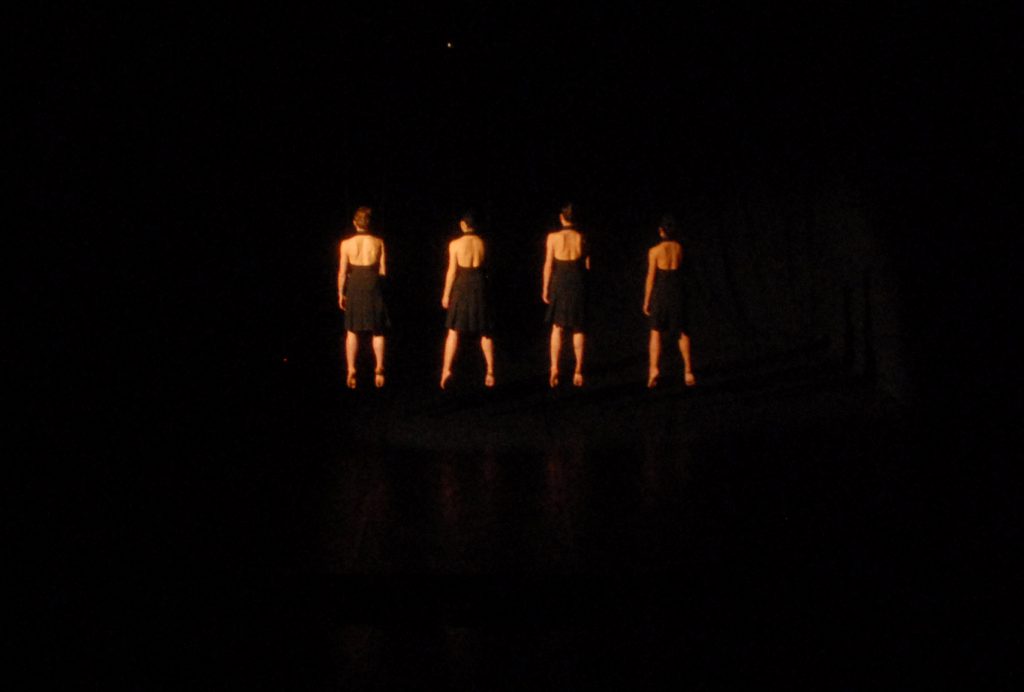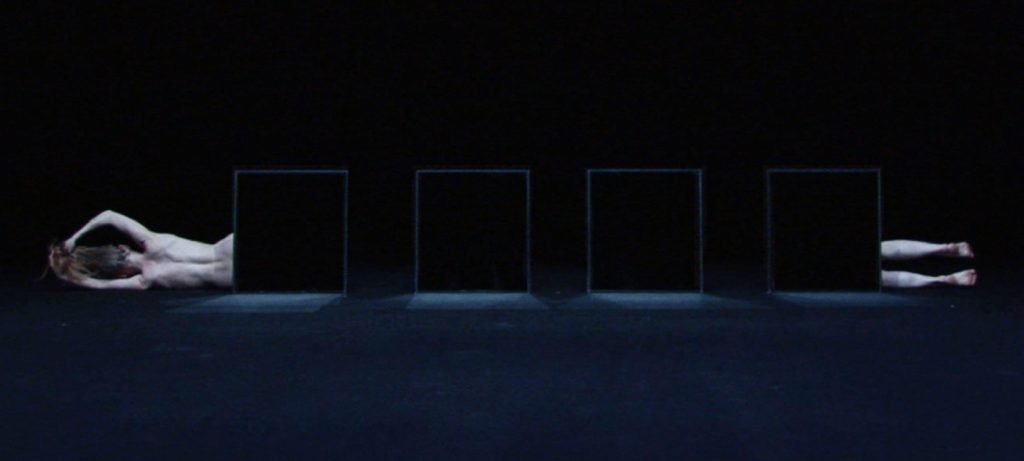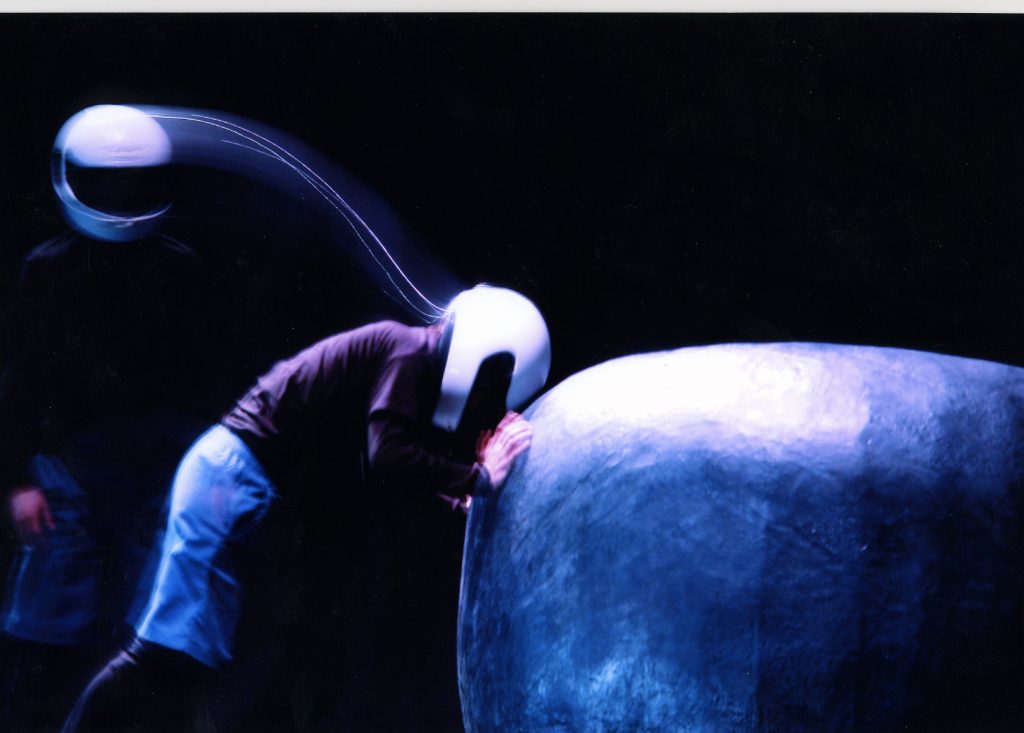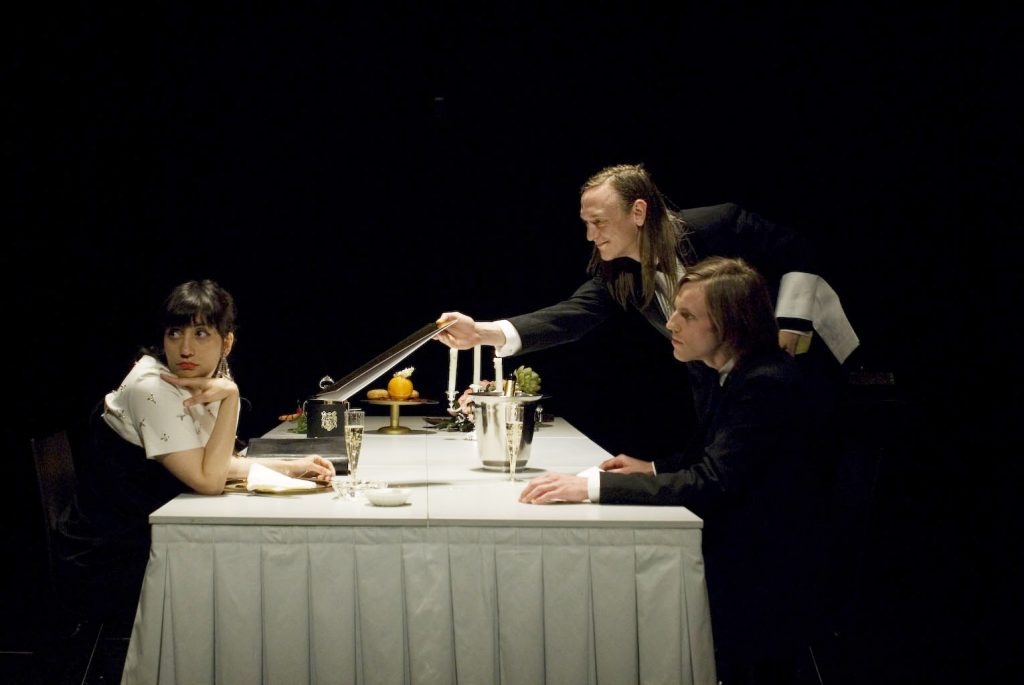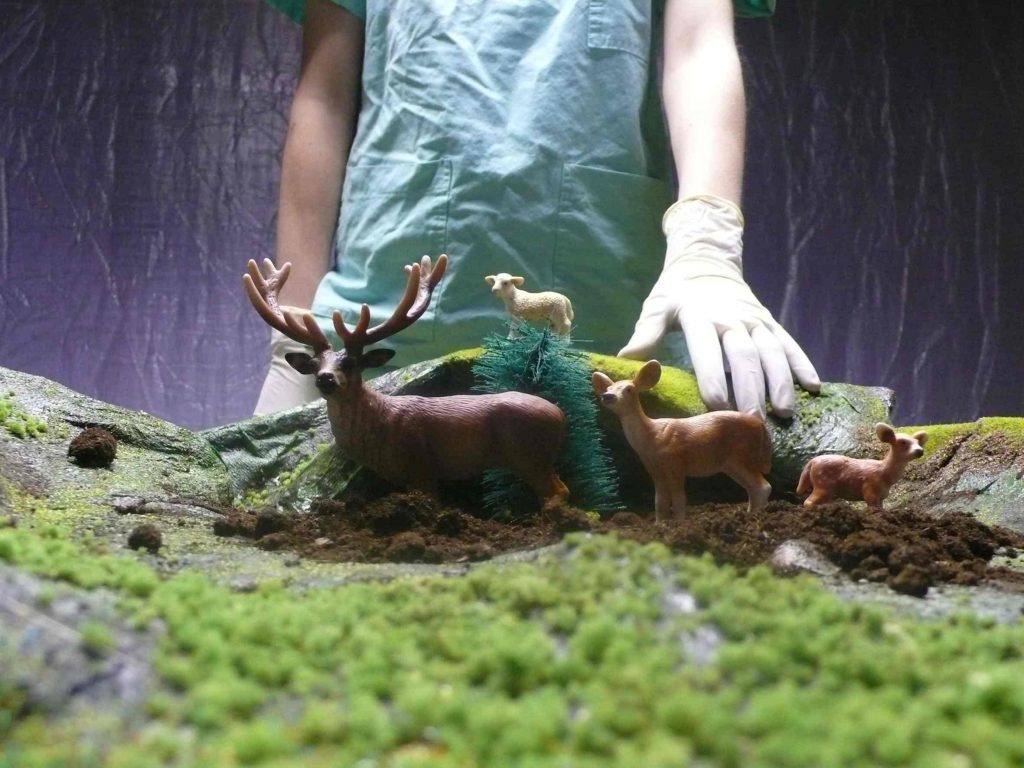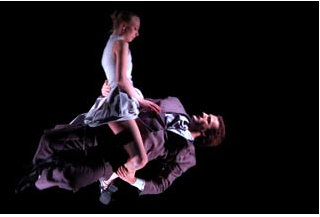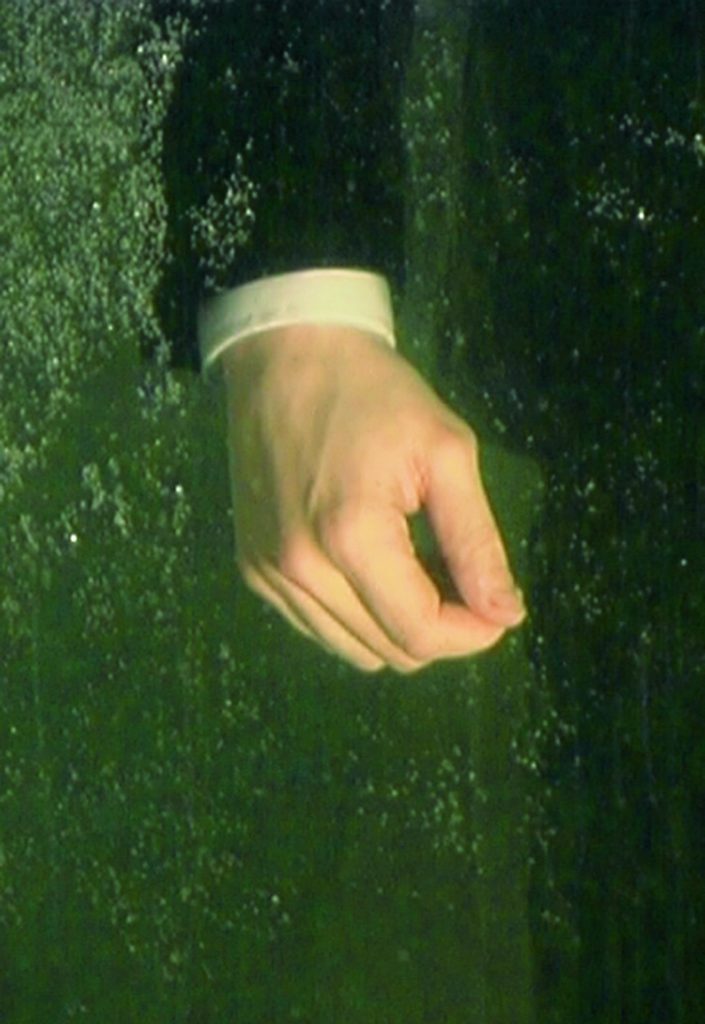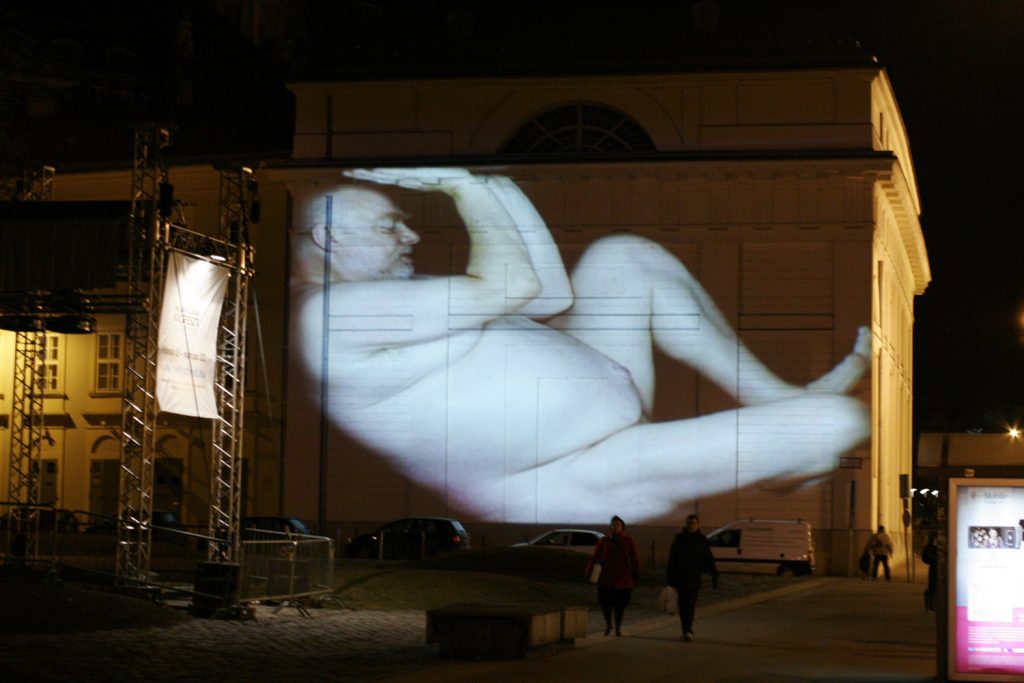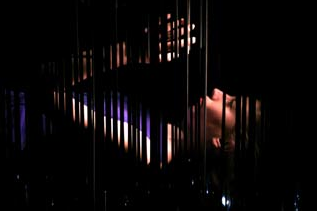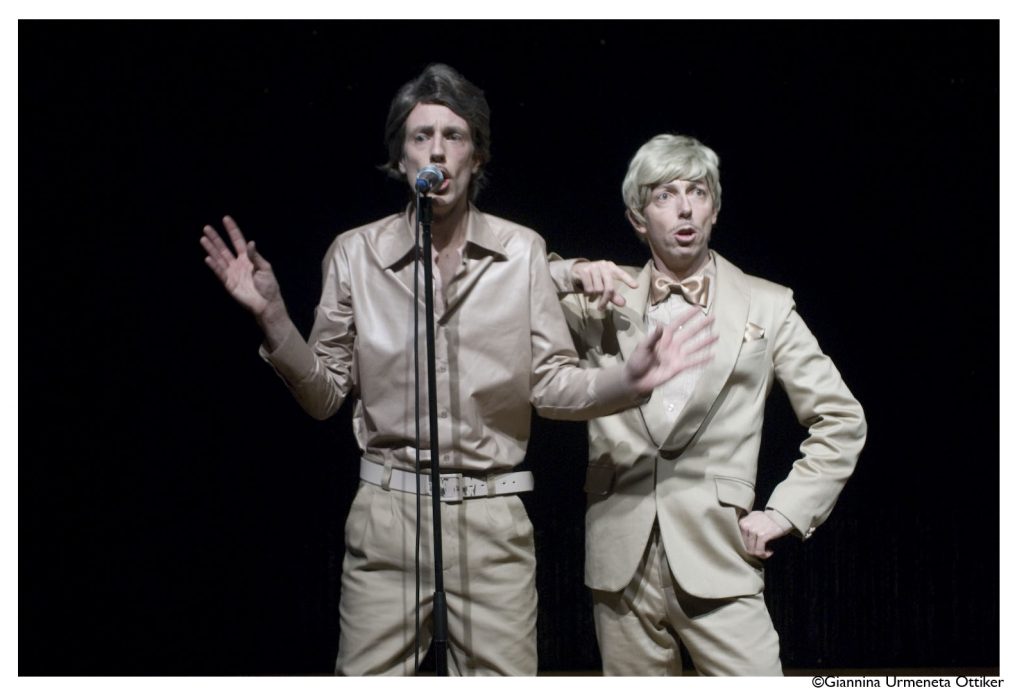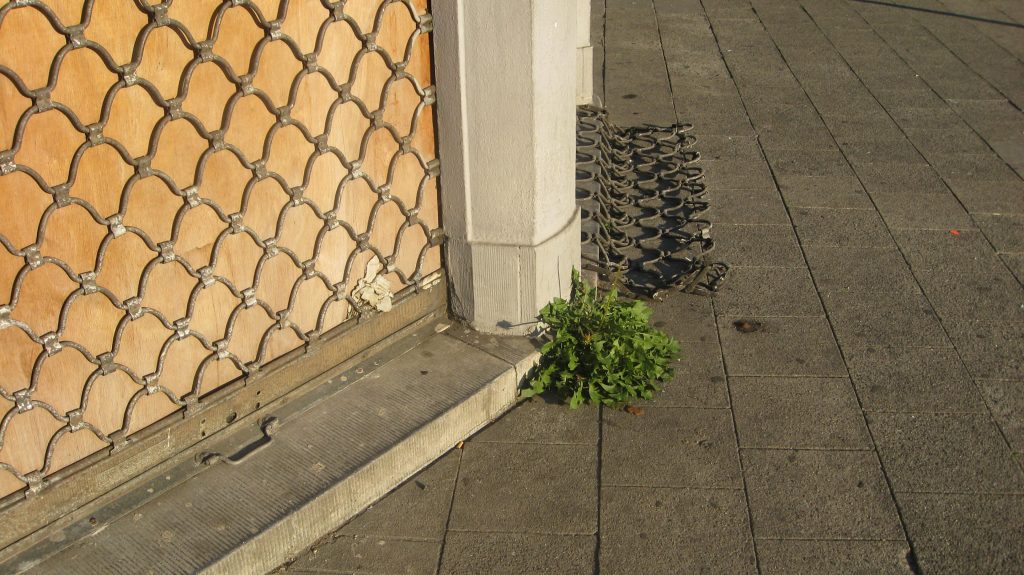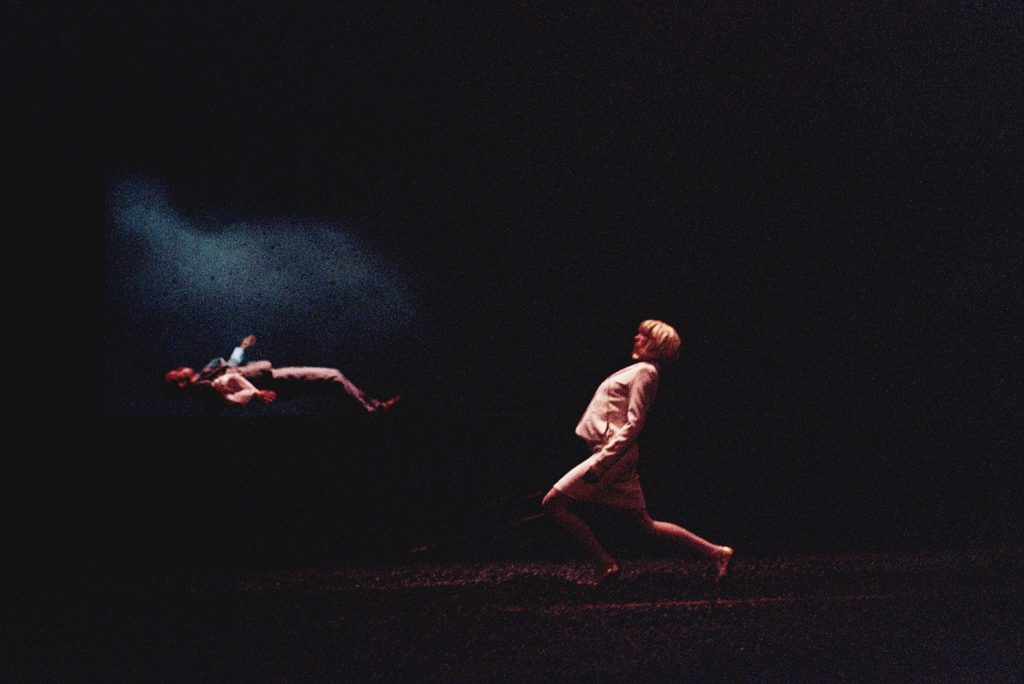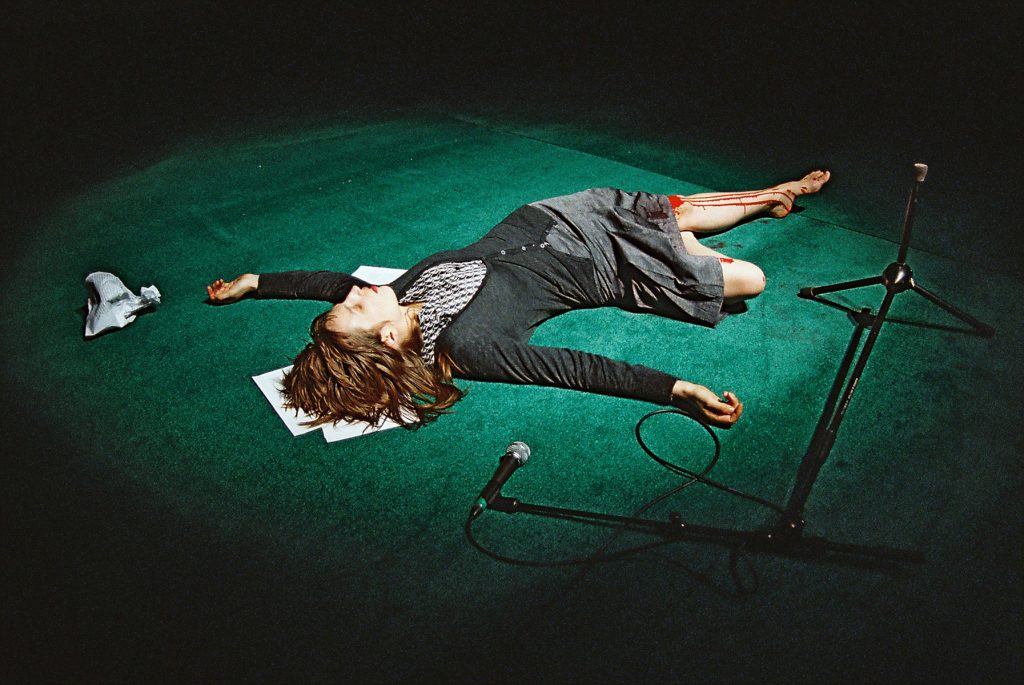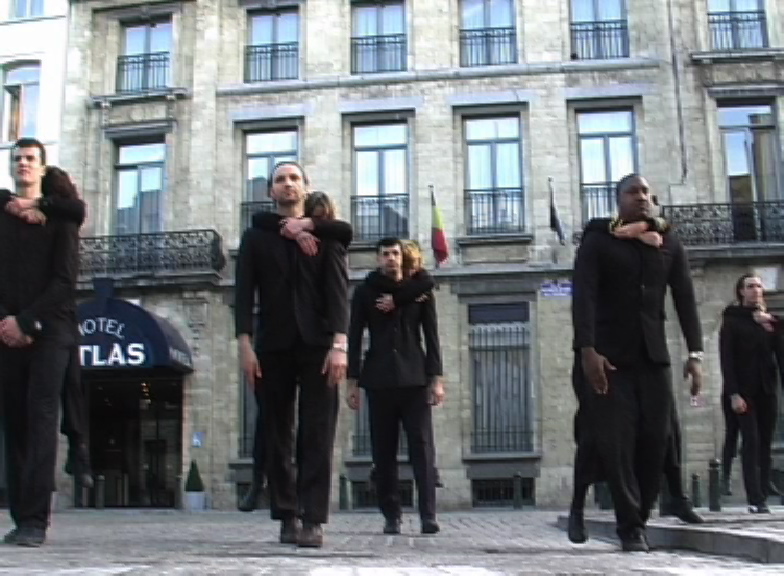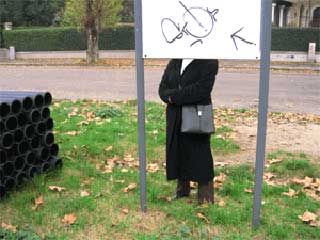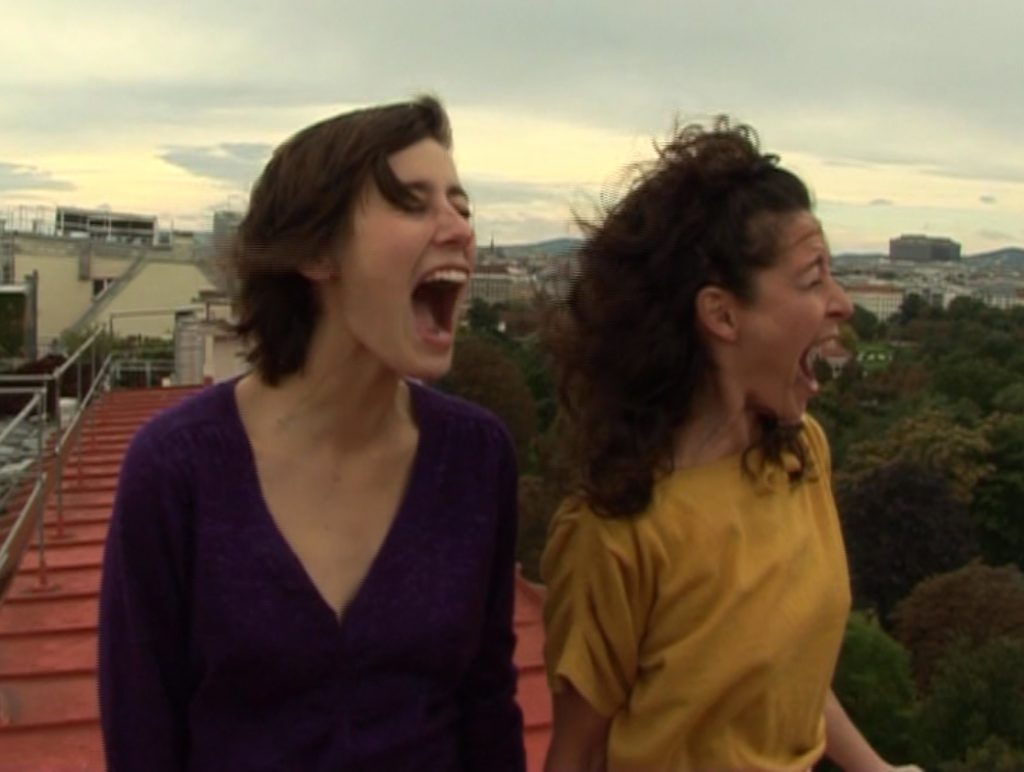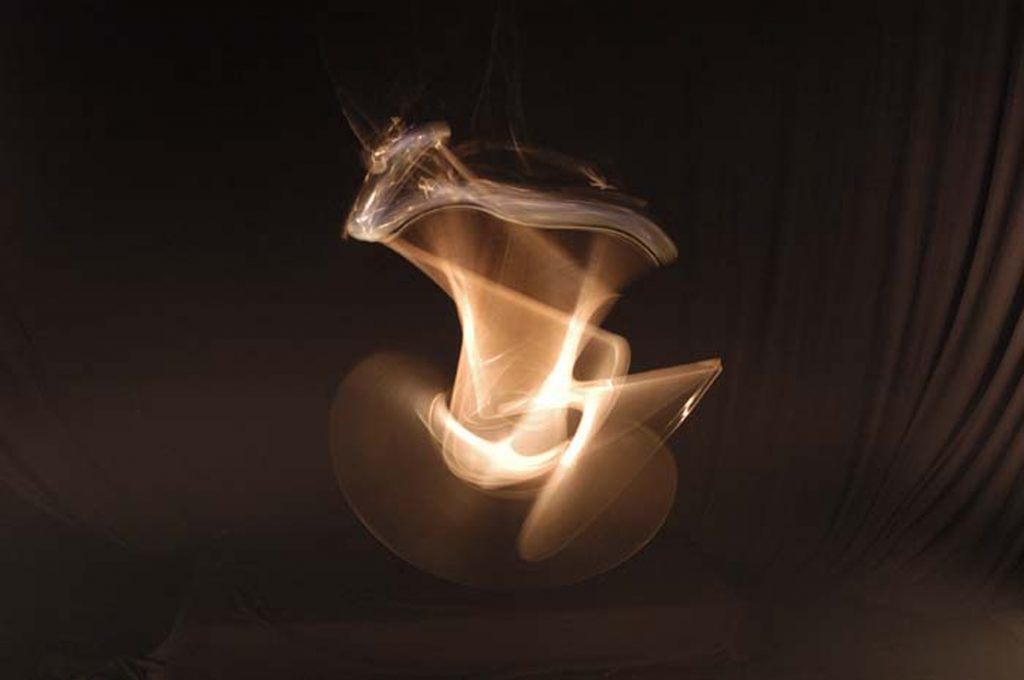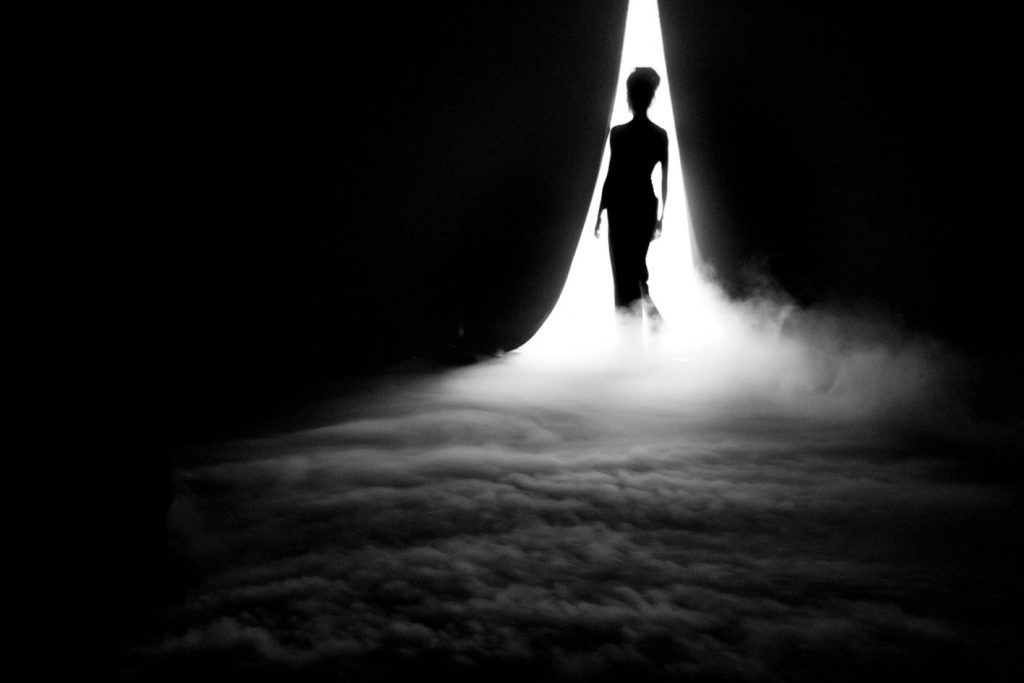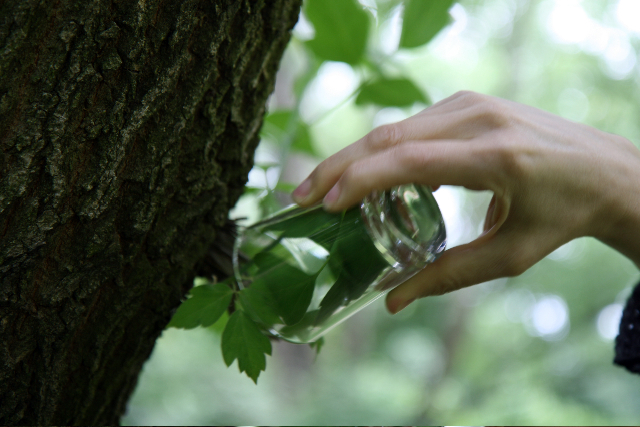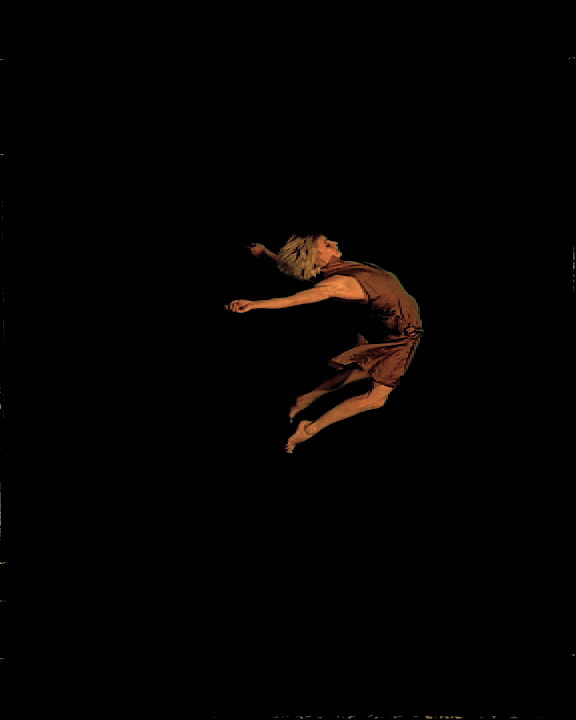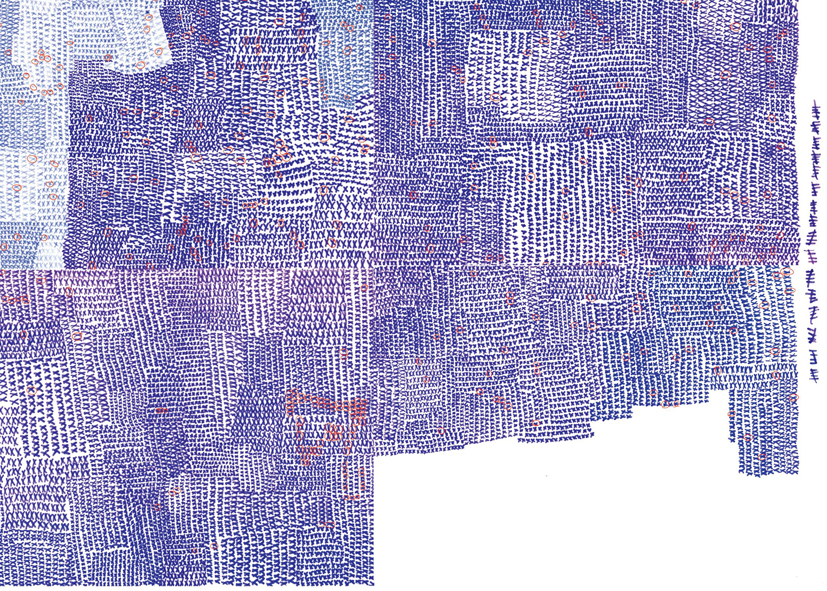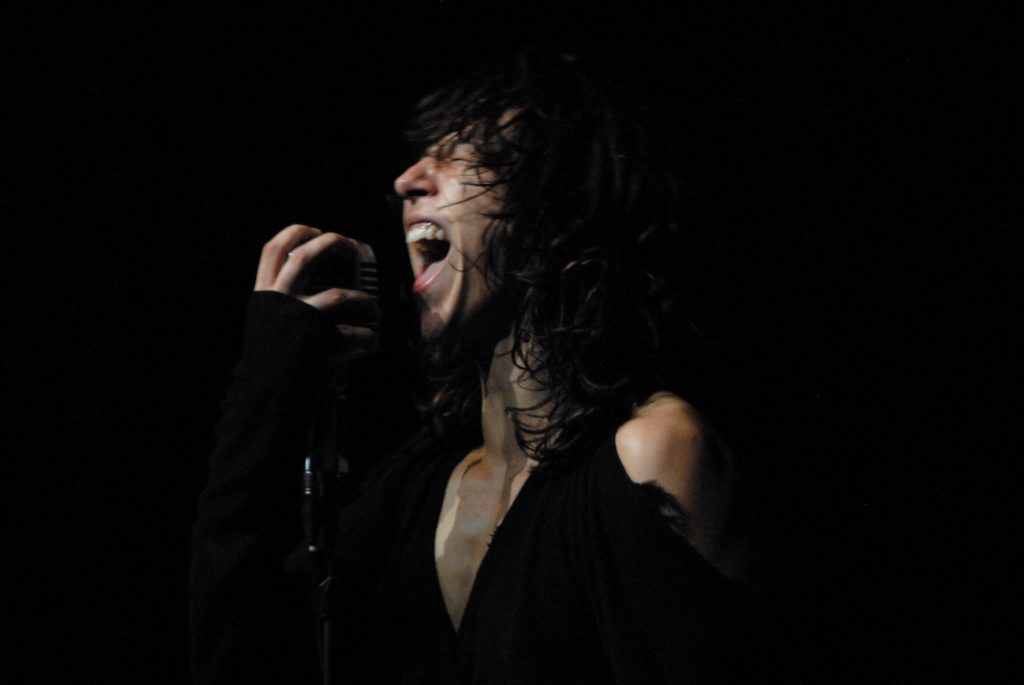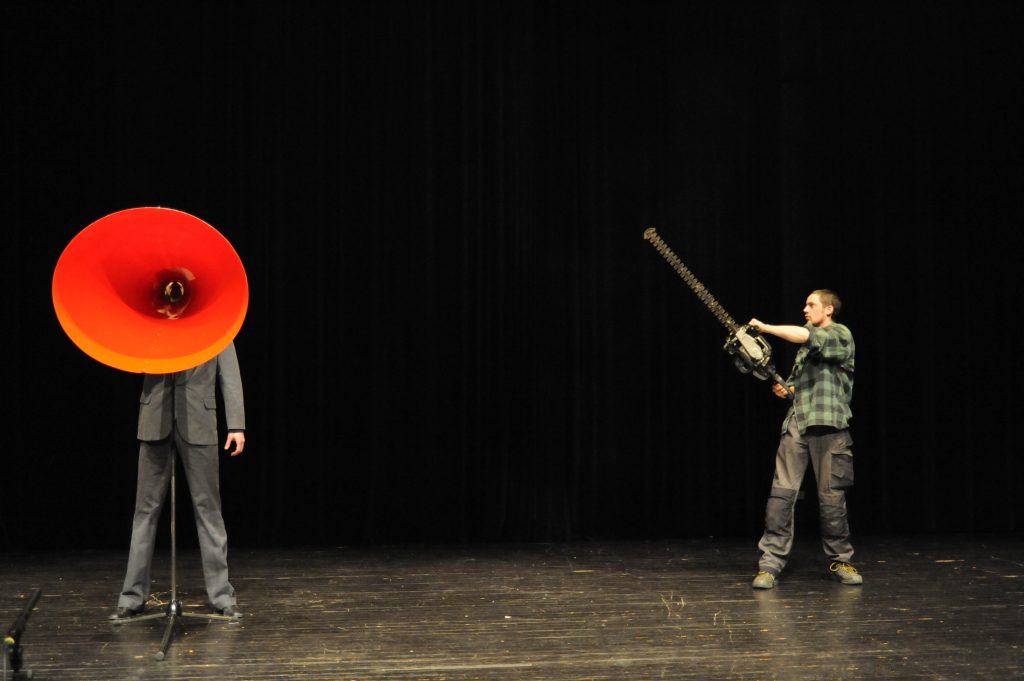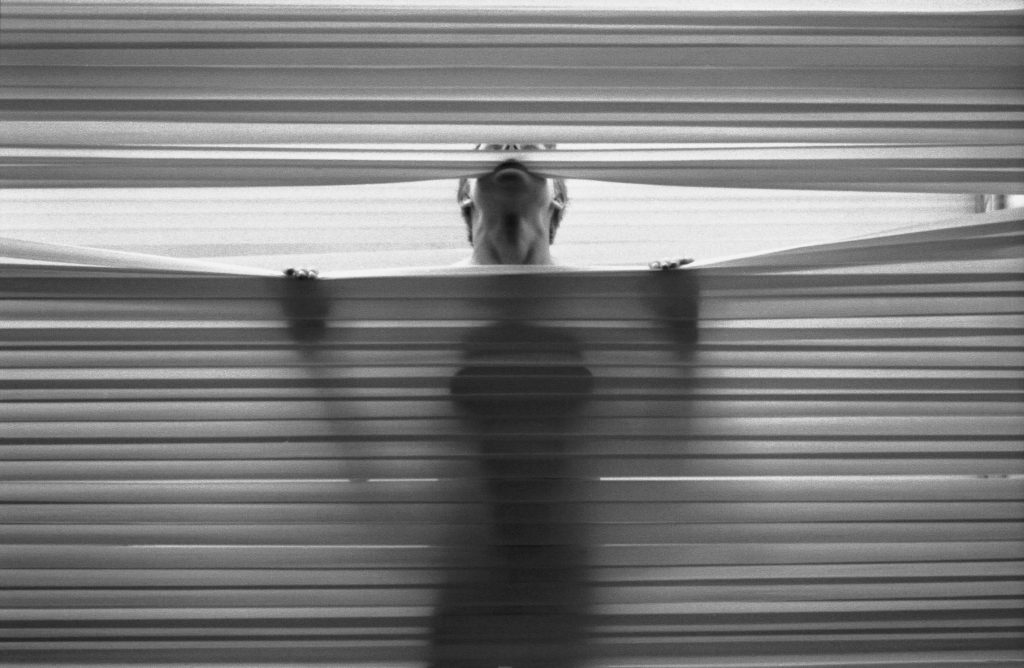I/II/III/IIII is a new theatrical installation by the performance artist Kris Verdonck. Four ‘identical’ female dancers hang like marionettes in a huge ‘machine’. Together with them performance artist Kris Verdonck generated a passage of choreography: a solo, a duet, a trio and a pas de quatre. They sought the greatest possible freedom from the machine, but sooner or later it sent them in the direction it decided upon. The images evoked by I/II/III/IIII are confusing, many-layered and ambiguous: they remind us of the white birds in Swan Lake and also of animal carcases being dragged along, hovering angels, falling human bodies and everything in between.
Agenda
Filter by artist
The Brussels artists Nico Boon, Gosie Vervloessem and Ann Van de Vyvere are taking five farm animals on a walk to the seaside. For several weeks, they will walk, sleep, eat and live with a cow, a pig, a sheep, a donkey, a chicken and a dog, just like nomads. Afterwards they will translate their experiences into a performance/show.
The argument of Specchi , two variations on “the woman cut into pieces” – located between dance and visual art – is the deconstruction of the female form. Here it would involve dismantling the mechanism of illusion, extrapolating it by bringing it into view and exposing on stage with mirrors that cut off, dislocate, derealize; boxes that contain, frame, absorb.
« What interests me is producing truncated forms in relation to image and composition. It is the creation of illuminated, unreal forms outside the immediacy of the bodies.The mirror creates unreal forms outside the immediacy of the bodies. The box is its negation: wrappings that cause a reduction of movement in bas-relief ».
In this visual distancing a specific emotional tension is produced, a kind of “mise en abyme” of what is being seen, a vibration of what is “present on stage”. In this project, the research topic for the female performers is the way the spectator sees women’s bodies. They are challenging collective iconography in order to create new poetic opportunities.
The art of falling
A nimble body in the void, suspended in the air as the centre of the universe. Incomplete wings, which overcome gravity for a split second. The triumphant plunge, before the final, fatal embrace. What goes on in the head of a person falling? In that short instant, in that eternity, between heaven and earth? Forever Overhead: is the first performance by Lisbeth Gruwez, who has been remarkable in productions by Jan Fabre, Sidi Larbi Cherkaoui and Jan Lauwers. Forever Overhead shows the body out of balance and is a physical drawing about the art of falling.
Hans Bryssinck + Diederik Peeters + D. ANESIADOU
Chuck Norris doesn’t sleep, he waits…
Waar, voorwaar, zijn de discrete charmes van de bourgeoisie gebleven? In hun enigmatisch klinkende ensemblestuk “Chuck Norris Doesn’t Sleep, He Waits…” nemen Danai Anesiadou, Hans Bryssinck en Diederik Peeters elk om beurt de rol van de even decadent als cinematisch icoon waar. Centraal in hun draaiboek van even absurdistisch als streng gechoreografeerde tableaux vivants staat de filmische representatie van aristocratisch ennui.
In “Chuck Norris” dalen onze argeloze protagonisten af in een labyrintische onderwereld van archaïsche codes en ondoorzichtige rituelen; het enige licht aan het einde van deze eindeloos lopende tunnel is dat van ouderwetse, groteske horror: een hartelijk aanbevolen schouwspel van alledaagse verbijstering.
With How do you like my landscape Manah Depauw and Bernard Van Eeghem use sharp imagination to redefine the place of the human body within our society, which is still prey to a puritanical eye and political correctness. By means of slight manipulation – disconcerning by its simplicity – Depauw and Van Eeghem remove the human body from its normal context and place it in unexpected situations. The four-episode spectacle takes place around a landscape where the apparent tranquillity only serves to camouflage terrible beasts that, given a chance would awaken in us all those desires that we prefer to remain hidden. The audience follows a world that transforms itself and develops through the four episodes.
1) Some different aspects of the installation HEART : A man and a woman are connected to each other with a rope, a steal cable, between them a ‘winch’, she stands in front of the audience, he on a ladder behind the curtains: when he jumps, she is pulled backwards 9m and 4m high and smashes against a wall. The man is invisible to the woman, but sometimes she felt when he wanted to jump.
2) The structure of the classical ‘pas de deux’: from this heavily coded material different movements will be distilled.
DESCRIPTION
A man and woman are in a situation of absolute mutual dependence. As opposed to the situation in HEART man and woman are visible for each other. They execute their dance movements in a live loop. These movements will be deconstructed and mechanically manipulated. The machine pushes them to repeat perfectly; for which they inevitably have to trust each other. They are left to each other.
An actress remains motionless for an hour in a display window filled with water. The distortion to her senses caused by the environment she is in makes her go into a trance. The sounds of her breathing and movement are amplified by microphones.
The Stills consist of gigantic projections: naked, voluminous human figures, imprisoned in a space which is much too small for them. They sometimes move slightly, seeking the most comfortable position in which to bear their uncertain situation. Still I & II was commissioned in September 2006 by La Notte Bianca in Rome. The pictures were projected onto one of the megalomaniac façades of the EUR, a suburb of Rome built by Mussolini. Despite their magnitude, the precarious position in which these naked, utterly fragile figures find themselves was in stark contrast to the self-assured, social-realist architecture. A similarly imposing and demagogically tainted location was sought – and found – in Brussels: the upper part of the Kunstberg.
The argument of Specchi , two variations on “the woman cut into pieces” – located between dance and visual art – is the deconstruction of the female form. Here it would involve dismantling the mechanism of illusion, extrapolating it by bringing it into view and exposing on stage with mirrors that cut off, dislocate, derealize; boxes that contain, frame, absorb.
« What interests me is producing truncated forms in relation to image and composition. It is the creation of illuminated, unreal forms outside the immediacy of the bodies.The mirror creates unreal forms outside the immediacy of the bodies. The box is its negation: wrappings that cause a reduction of movement in bas-relief ».
In this visual distancing a specific emotional tension is produced, a kind of “mise en abyme” of what is being seen, a vibration of what is “present on stage”. In this project, the research topic for the female performers is the way the spectator sees women’s bodies. They are challenging collective iconography in order to create new poetic opportunities.
A performer positions herself like a fakir on a bed of long iron spikes placed at a distance of 4cm from each other. Microphones are placed where the body touches the spikes to register the sound of the suspended body, and also create a larger supporting surface.
Like a fakir the performer manages to obtain her position through a state of deep meditation. And meditation suggests: transcending, crossing the border of a-conscious state to non-conscious state of being, from the active to the passive. Meditation also implies a “surrendering” through which we are able to use energy, normally spend on the fight against proper “schizophrenia”, for transformation.
BASIC ASSUMPTION: THE HUMAN BATTERY
On 30 th of June 2004 under ‘US Patent 6, 754,472’ the American Company Microsoft patented human energy. The patent protects: a method and apparatus for transmitting power and data using the human body (…), as a conductive medium over which power and/or data is distributed. The physical resistance offered by the human body could be used to create a virtual keyboard on a patch of skin. According to the patent, the intent is to reduce device redundancy for people carrying multiple devices, such as a phone, headset, handheld, and wristwatch that all include a speaker…
The art of falling
A nimble body in the void, suspended in the air as the centre of the universe. Incomplete wings, which overcome gravity for a split second. The triumphant plunge, before the final, fatal embrace. What goes on in the head of a person falling? In that short instant, in that eternity, between heaven and earth? Forever Overhead: is the first performance by Lisbeth Gruwez, who has been remarkable in productions by Jan Fabre, Sidi Larbi Cherkaoui and Jan Lauwers. Forever Overhead shows the body out of balance and is a physical drawing about the art of falling.
The Stills consist of gigantic projections: naked, voluminous human figures, imprisoned in a space which is much too small for them. They sometimes move slightly, seeking the most comfortable position in which to bear their uncertain situation. Still I & II was commissioned in September 2006 by La Notte Bianca in Rome. The pictures were projected onto one of the megalomaniac façades of the EUR, a suburb of Rome built by Mussolini. Despite their magnitude, the precarious position in which these naked, utterly fragile figures find themselves was in stark contrast to the self-assured, social-realist architecture. A similarly imposing and demagogically tainted location was sought – and found – in Brussels: the upper part of the Kunstberg.
One Man Snow is a late night act in which the entertainer is haunted by his bygone past. He re-lives moments from some other showbiz career, dreams about a show that he himself would have liked to see. There are fantasies and there is paranoia. He enters the show of his absurdist nightmares, haunted by the ghosts of entertainment. Secretly he’s expecting a special guest, he’s longing for the sound of a big band, but all he can get is just the smell of it! One Man Snow is a project by Hans Bryssinck and Christoph Hefti.
The argument of Specchi , two variations on “the woman cut into pieces” – located between dance and visual art – is the deconstruction of the female form. Here it would involve dismantling the mechanism of illusion, extrapolating it by bringing it into view and exposing on stage with mirrors that cut off, dislocate, derealize; boxes that contain, frame, absorb.
« What interests me is producing truncated forms in relation to image and composition. It is the creation of illuminated, unreal forms outside the immediacy of the bodies.The mirror creates unreal forms outside the immediacy of the bodies. The box is its negation: wrappings that cause a reduction of movement in bas-relief ».
In this visual distancing a specific emotional tension is produced, a kind of “mise en abyme” of what is being seen, a vibration of what is “present on stage”. In this project, the research topic for the female performers is the way the spectator sees women’s bodies. They are challenging collective iconography in order to create new poetic opportunities.
I/II/III/IIII is a new theatrical installation by the performance artist Kris Verdonck. Four ‘identical’ female dancers hang like marionettes in a huge ‘machine’. Together with them performance artist Kris Verdonck generated a passage of choreography: a solo, a duet, a trio and a pas de quatre. They sought the greatest possible freedom from the machine, but sooner or later it sent them in the direction it decided upon. The images evoked by I/II/III/IIII are confusing, many-layered and ambiguous: they remind us of the white birds in Swan Lake and also of animal carcases being dragged along, hovering angels, falling human bodies and everything in between.
The art of falling
A nimble body in the void, suspended in the air as the centre of the universe. Incomplete wings, which overcome gravity for a split second. The triumphant plunge, before the final, fatal embrace. What goes on in the head of a person falling? In that short instant, in that eternity, between heaven and earth? Forever Overhead: is the first performance by Lisbeth Gruwez, who has been remarkable in productions by Jan Fabre, Sidi Larbi Cherkaoui and Jan Lauwers. Forever Overhead shows the body out of balance and is a physical drawing about the art of falling.
One Man Snow is a late night act in which the entertainer is haunted by his bygone past. He re-lives moments from some other showbiz career, dreams about a show that he himself would have liked to see. There are fantasies and there is paranoia. He enters the show of his absurdist nightmares, haunted by the ghosts of entertainment. Secretly he’s expecting a special guest, he’s longing for the sound of a big band, but all he can get is just the smell of it! One Man Snow is a project by Hans Bryssinck and Christoph Hefti.
The art of falling
A nimble body in the void, suspended in the air as the centre of the universe. Incomplete wings, which overcome gravity for a split second. The triumphant plunge, before the final, fatal embrace. What goes on in the head of a person falling? In that short instant, in that eternity, between heaven and earth? Forever Overhead: is the first performance by Lisbeth Gruwez, who has been remarkable in productions by Jan Fabre, Sidi Larbi Cherkaoui and Jan Lauwers. Forever Overhead shows the body out of balance and is a physical drawing about the art of falling.
Hans Bryssinck + Diederik Peeters + D. ANESIADOU
Chuck Norris doesn’t sleep, he waits…
Waar, voorwaar, zijn de discrete charmes van de bourgeoisie gebleven? In hun enigmatisch klinkende ensemblestuk “Chuck Norris Doesn’t Sleep, He Waits…” nemen Danai Anesiadou, Hans Bryssinck en Diederik Peeters elk om beurt de rol van de even decadent als cinematisch icoon waar. Centraal in hun draaiboek van even absurdistisch als streng gechoreografeerde tableaux vivants staat de filmische representatie van aristocratisch ennui.
In “Chuck Norris” dalen onze argeloze protagonisten af in een labyrintische onderwereld van archaïsche codes en ondoorzichtige rituelen; het enige licht aan het einde van deze eindeloos lopende tunnel is dat van ouderwetse, groteske horror: een hartelijk aanbevolen schouwspel van alledaagse verbijstering.
The art of falling
A nimble body in the void, suspended in the air as the centre of the universe. Incomplete wings, which overcome gravity for a split second. The triumphant plunge, before the final, fatal embrace. What goes on in the head of a person falling? In that short instant, in that eternity, between heaven and earth? Forever Overhead: is the first performance by Lisbeth Gruwez, who has been remarkable in productions by Jan Fabre, Sidi Larbi Cherkaoui and Jan Lauwers. Forever Overhead shows the body out of balance and is a physical drawing about the art of falling.
Hans Bryssinck + Diederik Peeters + D. ANESIADOU
Chuck Norris doesn’t sleep, he waits…
Waar, voorwaar, zijn de discrete charmes van de bourgeoisie gebleven? In hun enigmatisch klinkende ensemblestuk “Chuck Norris Doesn’t Sleep, He Waits…” nemen Danai Anesiadou, Hans Bryssinck en Diederik Peeters elk om beurt de rol van de even decadent als cinematisch icoon waar. Centraal in hun draaiboek van even absurdistisch als streng gechoreografeerde tableaux vivants staat de filmische representatie van aristocratisch ennui.
In “Chuck Norris” dalen onze argeloze protagonisten af in een labyrintische onderwereld van archaïsche codes en ondoorzichtige rituelen; het enige licht aan het einde van deze eindeloos lopende tunnel is dat van ouderwetse, groteske horror: een hartelijk aanbevolen schouwspel van alledaagse verbijstering.
The Brussels artists Nico Boon, Gosie Vervloessem and Ann Van de Vyvere are taking five farm animals on a walk to the seaside. For several weeks, they will walk, sleep, eat and live with a cow, a pig, a sheep, a donkey, a chicken and a dog, just like nomads. Afterwards they will translate their experiences into a performance/show.
With How do you like my landscape Manah Depauw and Bernard Van Eeghem use sharp imagination to redefine the place of the human body within our society, which is still prey to a puritanical eye and political correctness. By means of slight manipulation – disconcerning by its simplicity – Depauw and Van Eeghem remove the human body from its normal context and place it in unexpected situations. The four-episode spectacle takes place around a landscape where the apparent tranquillity only serves to camouflage terrible beasts that, given a chance would awaken in us all those desires that we prefer to remain hidden. The audience follows a world that transforms itself and develops through the four episodes.
NEVERLAND is a video of professional Michael Jackson impersonator, Christophe Lesquesne performing as Michael Jackson.
The art of falling
A nimble body in the void, suspended in the air as the centre of the universe. Incomplete wings, which overcome gravity for a split second. The triumphant plunge, before the final, fatal embrace. What goes on in the head of a person falling? In that short instant, in that eternity, between heaven and earth? Forever Overhead: is the first performance by Lisbeth Gruwez, who has been remarkable in productions by Jan Fabre, Sidi Larbi Cherkaoui and Jan Lauwers. Forever Overhead shows the body out of balance and is a physical drawing about the art of falling.
The art of falling
A nimble body in the void, suspended in the air as the centre of the universe. Incomplete wings, which overcome gravity for a split second. The triumphant plunge, before the final, fatal embrace. What goes on in the head of a person falling? In that short instant, in that eternity, between heaven and earth? Forever Overhead: is the first performance by Lisbeth Gruwez, who has been remarkable in productions by Jan Fabre, Sidi Larbi Cherkaoui and Jan Lauwers. Forever Overhead shows the body out of balance and is a physical drawing about the art of falling.
The argument of Specchi , two variations on “the woman cut into pieces” – located between dance and visual art – is the deconstruction of the female form. Here it would involve dismantling the mechanism of illusion, extrapolating it by bringing it into view and exposing on stage with mirrors that cut off, dislocate, derealize; boxes that contain, frame, absorb.
« What interests me is producing truncated forms in relation to image and composition. It is the creation of illuminated, unreal forms outside the immediacy of the bodies.The mirror creates unreal forms outside the immediacy of the bodies. The box is its negation: wrappings that cause a reduction of movement in bas-relief ».
In this visual distancing a specific emotional tension is produced, a kind of “mise en abyme” of what is being seen, a vibration of what is “present on stage”. In this project, the research topic for the female performers is the way the spectator sees women’s bodies. They are challenging collective iconography in order to create new poetic opportunities.
With a group of fifteen participants, Irma Firma combs the neighbourhood in search of anything edible. How can we survive in a metropolis on tasty and nutritious ingredients provided by the city itself? Pick, forage and taste!
With How do you like my landscape Manah Depauw and Bernard Van Eeghem use sharp imagination to redefine the place of the human body within our society, which is still prey to a puritanical eye and political correctness. By means of slight manipulation – disconcerning by its simplicity – Depauw and Van Eeghem remove the human body from its normal context and place it in unexpected situations. The four-episode spectacle takes place around a landscape where the apparent tranquillity only serves to camouflage terrible beasts that, given a chance would awaken in us all those desires that we prefer to remain hidden. The audience follows a world that transforms itself and develops through the four episodes.
In END, the performance artist Kris Verdonck shows the possible final stages of a human society in ten scenes. Melting glaciers, burning forests, cities under water, ubiquitous screens and cameras spying on us, the uncontrolled availability of weapons of mass destruction, and so on.
END starts out from the images the media project onto our retinas all day and every day. The ten scenes are linked by a monologue spoken by a single character: the witness who sees it all happen. While this survivor – like the messenger in Greek tragedy – talks unceasingly, a series of ‘Figures’ appears on stage: machines and people or a combination of the two. They go from one side of the stage to the other, all in the same direction. Are they fleeing something? If so, what?
In END, the performance artist Kris Verdonck shows the possible final stages of a human society in ten scenes. Melting glaciers, burning forests, cities under water, ubiquitous screens and cameras spying on us, the uncontrolled availability of weapons of mass destruction, and so on.
END starts out from the images the media project onto our retinas all day and every day. The ten scenes are linked by a monologue spoken by a single character: the witness who sees it all happen. While this survivor – like the messenger in Greek tragedy – talks unceasingly, a series of ‘Figures’ appears on stage: machines and people or a combination of the two. They go from one side of the stage to the other, all in the same direction. Are they fleeing something? If so, what?
With How do you like my landscape Manah Depauw and Bernard Van Eeghem use sharp imagination to redefine the place of the human body within our society, which is still prey to a puritanical eye and political correctness. By means of slight manipulation – disconcerning by its simplicity – Depauw and Van Eeghem remove the human body from its normal context and place it in unexpected situations. The four-episode spectacle takes place around a landscape where the apparent tranquillity only serves to camouflage terrible beasts that, given a chance would awaken in us all those desires that we prefer to remain hidden. The audience follows a world that transforms itself and develops through the four episodes.
I/II/III/IIII is a new theatrical installation by the performance artist Kris Verdonck. Four ‘identical’ female dancers hang like marionettes in a huge ‘machine’. Together with them performance artist Kris Verdonck generated a passage of choreography: a solo, a duet, a trio and a pas de quatre. They sought the greatest possible freedom from the machine, but sooner or later it sent them in the direction it decided upon. The images evoked by I/II/III/IIII are confusing, many-layered and ambiguous: they remind us of the white birds in Swan Lake and also of animal carcases being dragged along, hovering angels, falling human bodies and everything in between.
With How do you like my landscape Manah Depauw and Bernard Van Eeghem use sharp imagination to redefine the place of the human body within our society, which is still prey to a puritanical eye and political correctness. By means of slight manipulation – disconcerning by its simplicity – Depauw and Van Eeghem remove the human body from its normal context and place it in unexpected situations. The four-episode spectacle takes place around a landscape where the apparent tranquillity only serves to camouflage terrible beasts that, given a chance would awaken in us all those desires that we prefer to remain hidden. The audience follows a world that transforms itself and develops through the four episodes.
Hans Bryssinck invited Werner Hirsch to mount a series of photos based on found footage and biographical imagery. In those photos they play with coincidence and the fact of finding oneself somewhere in between. Werner will really be in between everything: in between other things, but also between the devil and the deep sea and between pillar and post. Here again he shows the real chance, while he had yet scenes another fortuity. In the presentation, ending their working period, Werner will reinforce the confusion about what is real, what is a coincidence and what is fiction!
Hans Bryssinck + Diederik Peeters + D. ANESIADOU
Chuck Norris doesn’t sleep, he waits…
Waar, voorwaar, zijn de discrete charmes van de bourgeoisie gebleven? In hun enigmatisch klinkende ensemblestuk “Chuck Norris Doesn’t Sleep, He Waits…” nemen Danai Anesiadou, Hans Bryssinck en Diederik Peeters elk om beurt de rol van de even decadent als cinematisch icoon waar. Centraal in hun draaiboek van even absurdistisch als streng gechoreografeerde tableaux vivants staat de filmische representatie van aristocratisch ennui.
In “Chuck Norris” dalen onze argeloze protagonisten af in een labyrintische onderwereld van archaïsche codes en ondoorzichtige rituelen; het enige licht aan het einde van deze eindeloos lopende tunnel is dat van ouderwetse, groteske horror: een hartelijk aanbevolen schouwspel van alledaagse verbijstering.
1) Some different aspects of the installation HEART : A man and a woman are connected to each other with a rope, a steal cable, between them a ‘winch’, she stands in front of the audience, he on a ladder behind the curtains: when he jumps, she is pulled backwards 9m and 4m high and smashes against a wall. The man is invisible to the woman, but sometimes she felt when he wanted to jump.
2) The structure of the classical ‘pas de deux’: from this heavily coded material different movements will be distilled.
DESCRIPTION
A man and woman are in a situation of absolute mutual dependence. As opposed to the situation in HEART man and woman are visible for each other. They execute their dance movements in a live loop. These movements will be deconstructed and mechanically manipulated. The machine pushes them to repeat perfectly; for which they inevitably have to trust each other. They are left to each other.
Some stories are treason, some are dreamy, some are brutal, some are too funny to believe, some are too painful to tell straight, some are magical and others are poorly made, some might be the honest truth, and some are beautiful but hard to remember. A narrative is a slippery thing.
Kate McIntosh has collaborated with five writers to make the performance text for LOOSE PROMISE. She gave each of them the same set of narrative ingredients to start from, but asked each to write their own version of the story. The result is a collection of beautiful, difficult and compelling narratives. The stories are bound by their shared origin, but they head out in very different and surprising directions. The narratives of LOOSE PROMISE create worlds that echo each other, and yet can hardly co-exist. The performance itself, sparked by a fascination with the interdependence of stories, explores our compulsion to keep forming and digesting them….
With How do you like my landscape Manah Depauw and Bernard Van Eeghem use sharp imagination to redefine the place of the human body within our society, which is still prey to a puritanical eye and political correctness. By means of slight manipulation – disconcerning by its simplicity – Depauw and Van Eeghem remove the human body from its normal context and place it in unexpected situations. The four-episode spectacle takes place around a landscape where the apparent tranquillity only serves to camouflage terrible beasts that, given a chance would awaken in us all those desires that we prefer to remain hidden. The audience follows a world that transforms itself and develops through the four episodes.
With How do you like my landscape Manah Depauw and Bernard Van Eeghem use sharp imagination to redefine the place of the human body within our society, which is still prey to a puritanical eye and political correctness. By means of slight manipulation – disconcerning by its simplicity – Depauw and Van Eeghem remove the human body from its normal context and place it in unexpected situations. The four-episode spectacle takes place around a landscape where the apparent tranquillity only serves to camouflage terrible beasts that, given a chance would awaken in us all those desires that we prefer to remain hidden. The audience follows a world that transforms itself and develops through the four episodes.
With How do you like my landscape Manah Depauw and Bernard Van Eeghem use sharp imagination to redefine the place of the human body within our society, which is still prey to a puritanical eye and political correctness. By means of slight manipulation – disconcerning by its simplicity – Depauw and Van Eeghem remove the human body from its normal context and place it in unexpected situations. The four-episode spectacle takes place around a landscape where the apparent tranquillity only serves to camouflage terrible beasts that, given a chance would awaken in us all those desires that we prefer to remain hidden. The audience follows a world that transforms itself and develops through the four episodes.
I/II/III/IIII is a new theatrical installation by the performance artist Kris Verdonck. Four ‘identical’ female dancers hang like marionettes in a huge ‘machine’. Together with them performance artist Kris Verdonck generated a passage of choreography: a solo, a duet, a trio and a pas de quatre. They sought the greatest possible freedom from the machine, but sooner or later it sent them in the direction it decided upon. The images evoked by I/II/III/IIII are confusing, many-layered and ambiguous: they remind us of the white birds in Swan Lake and also of animal carcases being dragged along, hovering angels, falling human bodies and everything in between.
In END, the performance artist Kris Verdonck shows the possible final stages of a human society in ten scenes. Melting glaciers, burning forests, cities under water, ubiquitous screens and cameras spying on us, the uncontrolled availability of weapons of mass destruction, and so on.
END starts out from the images the media project onto our retinas all day and every day. The ten scenes are linked by a monologue spoken by a single character: the witness who sees it all happen. While this survivor – like the messenger in Greek tragedy – talks unceasingly, a series of ‘Figures’ appears on stage: machines and people or a combination of the two. They go from one side of the stage to the other, all in the same direction. Are they fleeing something? If so, what?
I/II/III/IIII is a new theatrical installation by the performance artist Kris Verdonck. Four ‘identical’ female dancers hang like marionettes in a huge ‘machine’. Together with them performance artist Kris Verdonck generated a passage of choreography: a solo, a duet, a trio and a pas de quatre. They sought the greatest possible freedom from the machine, but sooner or later it sent them in the direction it decided upon. The images evoked by I/II/III/IIII are confusing, many-layered and ambiguous: they remind us of the white birds in Swan Lake and also of animal carcases being dragged along, hovering angels, falling human bodies and everything in between.
Irma Firma
Cortegemanege: a small walk with giants
A small walk with giants’ is part of the project ‘cortegemanege’ in which multidisciplinary artists experiment from a fascination with parades. An important aspect is its public character and the walk; we always go from point a to b with a group of people. This time we work with ‘real’ giants, people that are at least 2m15 tall. Will the city be big enough for these people?
„I’ve been long enough here to know the system and to fish myself through. It was almost easier to be at that time without papers, because they ask you so many questions, they need so much papers, when you are in fact‚ sans papiers. If I didn’t cry, I saw somebody else cry. And if I didn’t cry and if somebody else didn’t cry, I saw someone else totaly losing it. They are aliens, they are actually aliens.”
Fragment from interview with Lisa Gunstone, dancer
A sensual discovery of the world by two alien girls and some strange encounters…
“The body is the physical aspect of the personality and movement is the personality made visible.” writes Mary Starks Whitehouse, who developed a practice in the 50′ called “Authentic Movement”.
A small walk with giants’ is part of the project ‘cortegemanege’ in which multidisciplinary artists experiment from a fascination with parades. An important aspect is its public character and the walk; we always go from point a to b with a group of people. This time we work with ‘real’ giants, people that are at least 2m15 tall. Will the city be big enough for these people?
„I’ve been long enough here to know the system and to fish myself through. It was almost easier to be at that time without papers, because they ask you so many questions, they need so much papers, when you are in fact‚ sans papiers. If I didn’t cry, I saw somebody else cry. And if I didn’t cry and if somebody else didn’t cry, I saw someone else totaly losing it. They are aliens, they are actually aliens.”
Fragment from interview with Lisa Gunstone, dancer
In END, the performance artist Kris Verdonck shows the possible final stages of a human society in ten scenes. Melting glaciers, burning forests, cities under water, ubiquitous screens and cameras spying on us, the uncontrolled availability of weapons of mass destruction, and so on.
END starts out from the images the media project onto our retinas all day and every day. The ten scenes are linked by a monologue spoken by a single character: the witness who sees it all happen. While this survivor – like the messenger in Greek tragedy – talks unceasingly, a series of ‘Figures’ appears on stage: machines and people or a combination of the two. They go from one side of the stage to the other, all in the same direction. Are they fleeing something? If so, what?
I/II/III/IIII is a new theatrical installation by the performance artist Kris Verdonck. Four ‘identical’ female dancers hang like marionettes in a huge ‘machine’. Together with them performance artist Kris Verdonck generated a passage of choreography: a solo, a duet, a trio and a pas de quatre. They sought the greatest possible freedom from the machine, but sooner or later it sent them in the direction it decided upon. The images evoked by I/II/III/IIII are confusing, many-layered and ambiguous: they remind us of the white birds in Swan Lake and also of animal carcases being dragged along, hovering angels, falling human bodies and everything in between.
A Las Vegas showgirl emerges from a month lost in the forest – muddy, disheveled and more animal than human. Somebody explains the expenses involved in being authentic. One woman reads pheromones. Another explains her ‘instinct for failure’.
A grinding wheel with a big steel L hangs from the ceiling. When the disc starts to turn, the L twirls round uncontrolled. The motor races but still tries to find its equilibrium, still tries to function despite the strangeness of the situation. However the machine does not succeed. It starts to take on the appearance of a classical hero in distress, with movement making the situation become more and more unbearable.
Some stories are treason, some are dreamy, some are brutal, some are too funny to believe, some are too painful to tell straight, some are magical and others are poorly made, some might be the honest truth, and some are beautiful but hard to remember. A narrative is a slippery thing.
Kate McIntosh has collaborated with five writers to make the performance text for LOOSE PROMISE. She gave each of them the same set of narrative ingredients to start from, but asked each to write their own version of the story. The result is a collection of beautiful, difficult and compelling narratives. The stories are bound by their shared origin, but they head out in very different and surprising directions. The narratives of LOOSE PROMISE create worlds that echo each other, and yet can hardly co-exist. The performance itself, sparked by a fascination with the interdependence of stories, explores our compulsion to keep forming and digesting them….
Exploding lights, smoking dance.
Or a multitude of vertigos.
Video Installation
Over one summer meeting Kate McIntosh and Eva Meyer-Keller came up with a game. Shifting through the city, from inside to out, they constructed small installations in the locations they found. They played a ping-pong of images between them – each action challenging the other to a reply. The result is a collection of short actions and unlikely installations – a constantly expanding inventory of the world, through mischievous re-placements of the things in it. The project is endless. There is a persistence and inquisitiveness about this catalogue of small crushings, traps, decorations, and repairs – there is an internal logic that can only be read as ‘putting things in the wrong place’ and yet which satisfies some curiosity, some desire, before passing quickly to the next. The rearrangements are subversive, cryptic, and at times mysterious relocations of banal materials in every-day environments. Each image is a fragment in a rolling, compiling world-view; a hands-on investigation of what-might-go-where, and what might happen when one ‘thing’ meets another.
This collaboration was the first stage of the FlashPoint project – a series of meetings in which Kate invites each time a different artist for a short collaboration.
His eyes are staring, his mouth is open, his wings are spread. This is how one pictures the angel of history. His face is turned toward the past. Where we perceive a chain of events, he sees one single catastrophe which keeps piling wreckage and hurls it in front of his feet. The angel would like to stay, awaken the dead, and make whole what has been smashed. But a storm is blowing in from Paradise; it has got caught in his wings with such a violence that the angel can no longer close them. The storm irresistibly propels him into the future to which his back is turned, while the pile of debris before him grows skyward. This storm is what we call progress. (Walter Benjamin, Angelus Novus )
A sensual discovery of the world by two alien girls and some strange encounters…
“The body is the physical aspect of the personality and movement is the personality made visible.” writes Mary Starks Whitehouse, who developed a practice in the 50′ called “Authentic Movement”.
A sensual discovery of the world by two alien girls and some strange encounters…
“The body is the physical aspect of the personality and movement is the personality made visible.” writes Mary Starks Whitehouse, who developed a practice in the 50′ called “Authentic Movement”.
Leentje Vandenbussche doesn’t only make performative pieces, her work also takes the shape of a visual arts practice. It is often in preparation of her performances, that (monk-like) graphical work and publications come to life, in a quest to overcome linguistics, and to visualize data. A human being tries to understand. The research method of Leentje Vandenbussche verges on insanity. By means of different drudgeries she has looked for something to hold on to in the vast subjects of all and nothing. Carried by (/subordinated to) an isolated, monotonous rhythm, her research studies give intriguing results. A fascinating view on all and nothing, a look behind the scenes of the performances.
An overview of former projects, dating from 2005 till today, is listed below.
The human body is a machine full of animal reflexes and signals. Our spirit drives that beautiful instrument, but what drives our mind?
BIRTH of PREY observes the routines, rituals and the body language between predator and prey.
Who is what, when and why? How do our instincts affect our bodies? How dependent are we of our drives and (how long) can we control them?
BIRTH of PREY, a circular ritual that gives form to the interaction between the rational instruction and the metaphysical emotion. The constant metamorphosis of the being.
In END, the performance artist Kris Verdonck shows the possible final stages of a human society in ten scenes. Melting glaciers, burning forests, cities under water, ubiquitous screens and cameras spying on us, the uncontrolled availability of weapons of mass destruction, and so on.
END starts out from the images the media project onto our retinas all day and every day. The ten scenes are linked by a monologue spoken by a single character: the witness who sees it all happen. While this survivor – like the messenger in Greek tragedy – talks unceasingly, a series of ‘Figures’ appears on stage: machines and people or a combination of the two. They go from one side of the stage to the other, all in the same direction. Are they fleeing something? If so, what?
In these Safety Instructions Hans Bryssinck holds speeches in which he attempts to say something truthful. Because he fears to say something truthful and because he fears loneliness he invites a guest alongside an object or a machine that relates to them. This can range from bikers (motorbike), cyclists (bike) and green workers (chainsaw) to householders (vacuum cleaner). The dynamic that is created between the speech and the guest with his machine describes the struggle of speaking and hearing the truth.
These are short and spontaneous performances that are adapted according to the context. The space in which they take place, the guests and the content of the speech may vary.
With How do you like my landscape Manah Depauw and Bernard Van Eeghem use sharp imagination to redefine the place of the human body within our society, which is still prey to a puritanical eye and political correctness. By means of slight manipulation – disconcerning by its simplicity – Depauw and Van Eeghem remove the human body from its normal context and place it in unexpected situations. The four-episode spectacle takes place around a landscape where the apparent tranquillity only serves to camouflage terrible beasts that, given a chance would awaken in us all those desires that we prefer to remain hidden. The audience follows a world that transforms itself and develops through the four episodes.
The human body is a machine full of animal reflexes and signals. Our spirit drives that beautiful instrument, but what drives our mind?
BIRTH of PREY observes the routines, rituals and the body language between predator and prey.
Who is what, when and why? How do our instincts affect our bodies? How dependent are we of our drives and (how long) can we control them?
BIRTH of PREY, a circular ritual that gives form to the interaction between the rational instruction and the metaphysical emotion. The constant metamorphosis of the being.
In END, the performance artist Kris Verdonck shows the possible final stages of a human society in ten scenes. Melting glaciers, burning forests, cities under water, ubiquitous screens and cameras spying on us, the uncontrolled availability of weapons of mass destruction, and so on.
END starts out from the images the media project onto our retinas all day and every day. The ten scenes are linked by a monologue spoken by a single character: the witness who sees it all happen. While this survivor – like the messenger in Greek tragedy – talks unceasingly, a series of ‘Figures’ appears on stage: machines and people or a combination of the two. They go from one side of the stage to the other, all in the same direction. Are they fleeing something? If so, what?
Video Installation
Over one summer meeting Kate McIntosh and Eva Meyer-Keller came up with a game. Shifting through the city, from inside to out, they constructed small installations in the locations they found. They played a ping-pong of images between them – each action challenging the other to a reply. The result is a collection of short actions and unlikely installations – a constantly expanding inventory of the world, through mischievous re-placements of the things in it. The project is endless. There is a persistence and inquisitiveness about this catalogue of small crushings, traps, decorations, and repairs – there is an internal logic that can only be read as ‘putting things in the wrong place’ and yet which satisfies some curiosity, some desire, before passing quickly to the next. The rearrangements are subversive, cryptic, and at times mysterious relocations of banal materials in every-day environments. Each image is a fragment in a rolling, compiling world-view; a hands-on investigation of what-might-go-where, and what might happen when one ‘thing’ meets another.
This collaboration was the first stage of the FlashPoint project – a series of meetings in which Kate invites each time a different artist for a short collaboration.
The human body is a machine full of animal reflexes and signals. Our spirit drives that beautiful instrument, but what drives our mind?
BIRTH of PREY observes the routines, rituals and the body language between predator and prey.
Who is what, when and why? How do our instincts affect our bodies? How dependent are we of our drives and (how long) can we control them?
BIRTH of PREY, a circular ritual that gives form to the interaction between the rational instruction and the metaphysical emotion. The constant metamorphosis of the being.
The human body is a machine full of animal reflexes and signals. Our spirit drives that beautiful instrument, but what drives our mind?
BIRTH of PREY observes the routines, rituals and the body language between predator and prey.
Who is what, when and why? How do our instincts affect our bodies? How dependent are we of our drives and (how long) can we control them?
BIRTH of PREY, a circular ritual that gives form to the interaction between the rational instruction and the metaphysical emotion. The constant metamorphosis of the being.
LOOM is a choreography for four female performers.
And/ or a video installation.
LOOM questions the appearing/disappearing of the body and introduces a gradual revealing of the body; it’s a move from a barely visible shadow that is occupying the whole performance stage thanks to motion.
With How do you like my landscape Manah Depauw and Bernard Van Eeghem use sharp imagination to redefine the place of the human body within our society, which is still prey to a puritanical eye and political correctness. By means of slight manipulation – disconcerning by its simplicity – Depauw and Van Eeghem remove the human body from its normal context and place it in unexpected situations. The four-episode spectacle takes place around a landscape where the apparent tranquillity only serves to camouflage terrible beasts that, given a chance would awaken in us all those desires that we prefer to remain hidden. The audience follows a world that transforms itself and develops through the four episodes.
